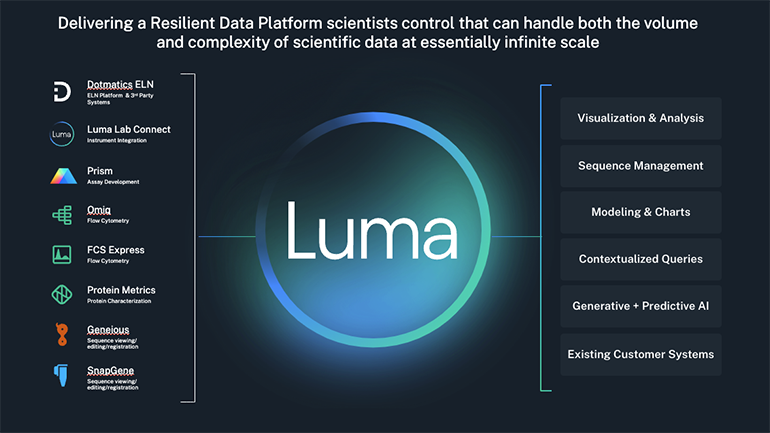Dotmatics, an R&D scientific software company connecting science, data, and decision-making, announces the launch of Dotmatics Luma, a revolutionary new scientific data platform that helps scientists and administrators in life sciences unify and analyze large volumes of data for better decision-making. Luma provides customers an out-of-the-box, low-code SaaS platform that flexibly aggregates all relevant data into intelligent data structures enabling clean, reliable data analysis and paving the way for meta-analysis and AI & ML-based algorithms.
 Rapid growth in the volume of scientific data has created bottlenecks for scientists, who must routinely create workarounds to access data in difficult places requiring them to step away from their primary work of discovery. For scientific organizations, the return on investment of R&D has decreased substantially over the past decade, even while technologies have purported to help ROI and aid in digital transformation.
Rapid growth in the volume of scientific data has created bottlenecks for scientists, who must routinely create workarounds to access data in difficult places requiring them to step away from their primary work of discovery. For scientific organizations, the return on investment of R&D has decreased substantially over the past decade, even while technologies have purported to help ROI and aid in digital transformation.
“With Dotmatics Luma, we are empowering scientists to answer their most difficult questions by delivering an adaptable scientifically aware data platform that scientists can easily control, and that can handle both the volume and complexity of data at an exponential scale,” said Thomas Swalla, Dotmatics’ CEO. “Our goal is to help life science companies shorten the drug discovery funnel and reduce the costs of drug therapy R&D from billions to millions of dollars.”
The challenge of harmonizing instrument data in the lab
Within any lab, the collection of disparate instruments creates a time-intensive exercise to align the data outputs which are handled differently from instrument to instrument. Some instrument outputs are encrypted with outputs that aren’t human readable which forces the use of vendor-specific tools and manual annotation of results or requires a series of scripts and parsers to read and access the data. Non-file-based instruments frequently lack intelligible APIs or SDKs, forcing advanced scripting and modeling activities on R&D teams who must learn and create esoteric models to fully access their data.
As humans work to coalesce the various outputs that are required to make sense of the data outputs across instruments, there are significant data integrity risks introduced. As instrumentation manufacturers update and change formats, labs find that scripts break and require updates which halts any automated data wrangling or analysis efforts.
The challenge of harmonizing data from instruments can reduce the freedom of choice for companies with a long history with a single vendor and their outputs and leads to long onboarding times for new instruments or expensive migrations to update data models for historic data.
These instrumentation challenges, combined with the general challenges and cost of maintaining on-premises or client-cloud solutions, ultimately result in significant IT overhead costs and time to manage, creating drastic increases in the overall time and costs of R&D.
Centralize data from any instrument using Luma Lab Connect
To address these instrumentation challenges in the lab and as the first component of Luma to be released, Dotmatics now offers Luma Lab Connect to drive FAIR data through automated data management and data wrangling of instrument files.
 Using Luma Lab Connect, customers can ingest files from any file-based instrument into the Dotmatics cloud. The Luma Lab Connect parsing engine automatically parses files to extract and wrangle embedded descriptive metadata and scientific data with minimal configuration. Agents are remotely managed, monitored by Dotmatics for stability, and require no configuration beyond instructions on which directories to watch for new data. The data is then automatically made available for modeling and enrichment within the broader Luma Platform.
Using Luma Lab Connect, customers can ingest files from any file-based instrument into the Dotmatics cloud. The Luma Lab Connect parsing engine automatically parses files to extract and wrangle embedded descriptive metadata and scientific data with minimal configuration. Agents are remotely managed, monitored by Dotmatics for stability, and require no configuration beyond instructions on which directories to watch for new data. The data is then automatically made available for modeling and enrichment within the broader Luma Platform.
The result through Luma is a harmonized and value-driven approach to ingesting, extracting, accessing, and integrating FAIR data which empowers scientists and reduces the burden on IT, collectively reducing the time and costs of R&D.
A revolutionary vision for Luma
As customers look to the future capabilities of Luma, Dotmatics will add AI functionality with generative AI query-building options and over time predictive and adaptive AI that will greatly augment lab testing and decision-making procedures. Key features of Luma will include:
- Low-code app building platform: Built on Databricks, customers can build scientific applications with common design patterns to power the next generation of data science and bench science.
- Your data – whenever, wherever, however you want it: Data is ingested from Dotmatics ELN, Data Discovery, Luma Lab Connect, and can encompass a variety of data sources such as animal studies, clinical studies, material registries, files, or other scientific systems. That data can then be modeled, stored, processed, or extracted as necessary — all with a governance framework that customers define.
- Maximize the value of your data: Customers get the most out of their data through a data value chain that progressively enriches, correlates, contextualizes, and increases the value of data. Ingest data into raw storage for immediate access in its original unstructured or semi-structured format; model logical tables, columns, and relationships to harmonize and establish connections between disparate data silos; execute more advanced data processing and enrichment activities on top of your structured data; and much more.
- API First: Supports on-demand access to your data. Choose from REST, GraphQL, or JDBC to enable your internal or 3rd party tools, such as Tableau, PowerBI, or Spotfire.
For more information about Dotmatics Luma, visit http://dotmatics.com/luma-data-management-platform.





Very good platform, but can not helpfull to astronomically data analysis.
there are ways to store data/do things that don’t take up space
the less space something takes up, the less computation that you have to do on it
call me.